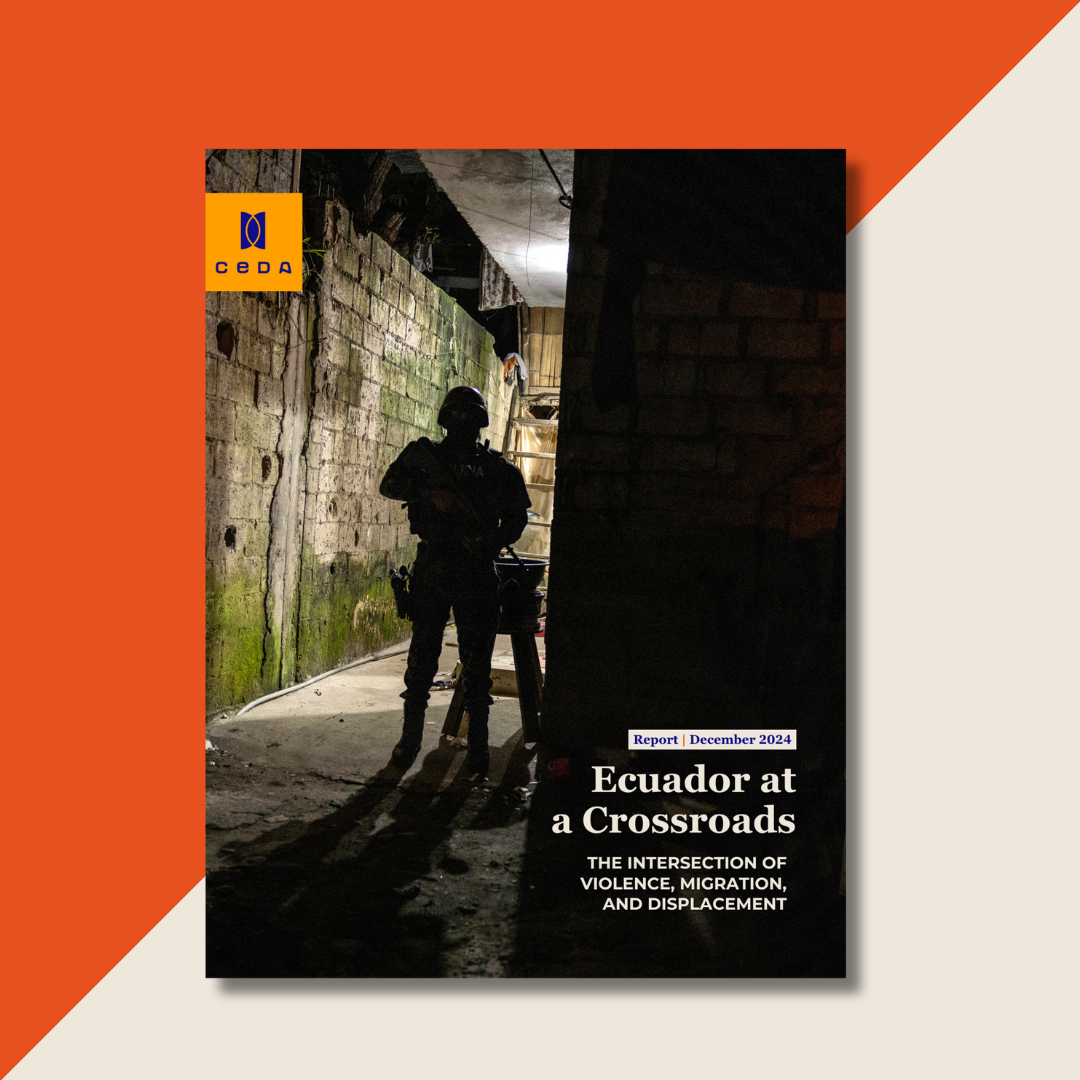Ecuador at a Crossroads: The Intersection of Violence, Migration, and Displacement
Author: Francisca Vigaud-Walsh
CEDA’s latest report delves into the concurrent crises and resulting migration in and out of Ecuador.
Ecuador At A Crossroads: The Intersection of Violence, Migration and Displacement
Ecuadorian migrants, with their hands and feet handcuffed, line up to climb a plane at the Albrook Gelabert airport in Panama City on August 29, 2024, during their deportation. (Martin Bernetti/AFP, licensed by Getty)
Ecuador stands at a crossroads as it navigates a confluence of crises—intensifying violence, the expansion of organized crime, economic fragility, and the escalating impacts of climate change. These overlapping pressures are reshaping the country’s migration landscape—driving internal displacement, prompting an unprecedented exodus of Ecuadorians, and altering the experiences of long-established migrant populations, including Venezuelans who once sought refuge in Ecuador. Key challenges and evolving dynamics include:
A New Dimension of Internal Displacement
Internal displacement in Ecuador—affecting both Ecuadorians and long-resident migrant communities—underscores a critical gap in preparedness. While evidence remains largely anecdotal and comprehensive data are still forthcoming, many internally displaced persons face precarious conditions, struggling to access protection, shelter, and livelihoods. Without coordinated and timely responses, these populations—displaced by violence, extortion, and forced recruitment—may seek stability elsewhere, potentially compounding regional migration challenges.
Crime in Ecuador Causes Escalating Emigration
Once an “island of peace,” Ecuador now hosts some of the world’s most violent cities amid competition over illicit economies. Crippling extortion, austerity measures, and climate-induced shocks have driven growing numbers of Ecuadorians—and some long-established migrant communities, such as Venezuelans—to seek refuge and opportunity abroad. Much of this flow is directed toward the United States, despite containment measures along the migratory corridor. Visa restrictions, perilous journeys, and complex transit routes have done little to deter movements. If underlying conditions remain unaddressed, these trends are likely to escalate in scale and complexity.
A map shows homicide rates in Ecuador by city in 2023.
Ongoing and New Refugee Arrivals to Ecuador
Colombia’s protracted conflicts continue to drive families into Ecuador, adding to the strain on an already overstretched humanitarian infrastructure. Services tailored primarily to Venezuelan refugees and migrants must now also support newly arriving Colombians, as well as additional Venezuelans fleeing continued instability. Without increased investments and targeted assistance, Ecuador risks leaving an expanding number of Colombians, Venezuelans, and other newcomers without the support they urgently require.
Migrants’ Regularization and Integration Barriers
Efforts to regularize large migrant populations—especially Venezuelans—are hindered by bureaucratic hurdles, high fees, and stringent documentation requirements. Although over 95 percent of surveyed Venezuelan households express a desire to remain in Ecuador, barriers to education, employment, and financial inclusion undermine their prospects. Continued investments in integration are essential to harness economic potential, reduce xenophobia, and foster social cohesion.
Legislative Reforms and Governance Gaps
Ecuador’s migration governance framework, anchored in the Organic Law on Human Mobility (LOMH), requires modernization to address contemporary realities. Civil society-informed legislative reforms offer a pathway to strengthen protections, streamline regularization, and align policies with constitutional and international commitments. However, these reforms must be enacted swiftly, implemented transparently, and supported by robust institutional capacity. Equally urgent is the need to establish a legal framework for internal displacement. Without such legislation, internally-displaced persons remain particularly vulnerable, and Ecuador risks fueling onward movement.
Human Rights Defenders Under Threat
Amid escalating violence and environmental conflicts, human rights defenders and community leaders face intimidation, violence, and forced displacement. Establishing a robust protection mechanism for them—through shelters, emergency support, and international backing—is essential to safeguard those advocating for human rights and environmental justice.
The Critical Role of the United States and International Engagement
U.S. initiatives, such as family reunification, humanitarian parole, and Safe Mobility Offices, have provided safe and regular migration pathways, alleviating regional pressures. However, potential policy shifts under the Trump-Vance administration—such as cuts in humanitarian aid, the termination of legal pathways, or mass deportations—threaten to destabilize Ecuador further. To avert a deeper humanitarian crisis and deter irregular migration, the United States and other international partners must maintain and adapt their support, prioritizing humanitarian assistance and root-cause solutions over security-focused measures alone.
Ecuador’s Path Forward
Ecuador’s overlapping crises demand urgent, rights-based, and multi-pronged solutions. By advancing legal frameworks for internal displacement and expediting inclusive policy reforms, Ecuador can better protect vulnerable populations, stabilize communities, and strengthen its migration governance. Now is the time for Ecuador’s partners–donors, multilateral development banks, the private sector, UN agencies, humanitarian organizations, and civil society–to provide the critical technical, financial, and diplomatic support to help the country strengthen its migration governance framework. By providing flexible funding, expertise, and sustained engagement, these external stakeholders can help Ecuador navigate its current challenges and move toward a more sustainable, inclusive, and resilient migration system—one that respects human rights, upholds dignity, and fosters regional stability.
Top line Recommendations to Address Ecuador’s Crises of Violence, Migration and Displacement:
Enact a Legal Framework for Internal Displacement: Close the protection gap for both Ecuadorians and resident migrant communities by adopting comprehensive legislation that clearly defines responsibilities, improves coordination, and enables swift, rights-based responses to internal displacement.
Streamline Migrant Regularization and Protection Measures: Centralize and simplify regularization processes, remove administrative barriers, and prioritize vulnerable groups, and —ensuring that migrants can access documentation, essential services, and sustained protection.
Strengthen Migration Governance and Implement Participatory Reforms: Swiftly adopt and implement human mobility law reforms developed through inclusive consultations with civil society, refugees, and migrants, ensuring alignment with constitutional principles and international human rights standards. Enhance institutional capacity, establish oversight mechanisms, and foster transparency, accountability, and broad stakeholder engagement in migration policy.
Enhance Humanitarian Preparedness and Expand Financing: Increase support for shelters, essential services, and targeted assistance to newly arriving Colombians, at-risk Venezuelans, and internally displaced persons. Donors and humanitarian actors should commit to flexible, needs-driven financing that adapts to evolving conditions. Resources should also be allocated to protecting human rights defenders, reducing xenophobia, and strengthening data-driven planning and public-private partnerships.
Address Root Causes and Reduce Emigration Pressures: The United States and other partners should maintain humanitarian aid, expand legal migration pathways, and invest in addressing poverty, insecurity, and governance gaps, rather than relying predominantly on deterrence measures. Governments in the region should prepare for potential shifts in U.S. policies affecting Ecuadorians abroad. Countries of asylum should adopt and apply the Cartagena Declaration’s expanded refugee definition when adjudicating asylum claims from Ecuadorian nationals.



